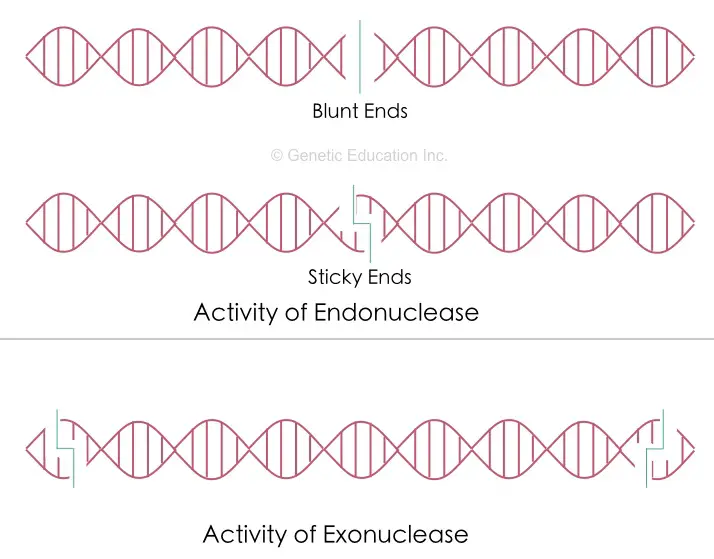“The endonuclease cleaves DNA inside while the exonuclease cuts DNA on both ends (3’ and 5’).”
Nucleases have special importance in genetics, recombinant DNA technology and genetic engineering for various applications. Due to their immense capacity to cleave the DNA or RNA, they are used in various assays.
We are familiar with one of the common types of endonuclease we are using in our lab, that is the restriction endonuclease. The restriction endonuclease cleaves DNA at its recognition site.
To produce various cleaves or restriction sites, we are using different restriction digestion enzymes, are endonucleases in nature.
In a cell nuclease cuts DNA to perform various functions, for example, nucleases cut DNA to repair it. At a site of DNA damage, it cleaves the DNA and releases the tension to facilitate the polymerase activities.
We know that cleaved DNA can affect our health adversely if it remains unrepaired, but along with DNA synthesis, DNA cleaving is also important.
Endonuclease and exonuclease are the two most common types of nucleases found. Both have some common similarities and differences. In the present article, we are discussing some of the differences and similarities between both.
Key Topics:
Endonuclease vs exonuclease: Differences
‘Endo’ –inside, ‘Exo’ –outside.
The endonuclease cleaves or cuts the DNA from inside or in between the sequence while the exonuclease cut the DNA on the ends.
The function of nuclease is to cut the DNA, it cleaves the phosphodiester bonds between the DNA, between the adjacent nucleotides and separates it.
What does it mean to inside or outside? See the image below,

The endonuclease cleaves the polynucleotide chain in between or away from ends. While the exonuclease breaks DNA on either 3’ OH or 5’ P or both ends. However, there is a reason behind that.
The endonuclease doesn’t need free 3’ or 5’ to start its activity but that is not the case with ‘Exo’ one. The exonuclease requires free ends of either 5’ phosphate or 3’ hydroxyl group to set up and catalyze the reaction.
Another prominent difference between the endonuclease and the exonuclease is the specificity. The endonucleases are highly specific means are very much sequence-specific. It only cut the DNA at its specific recognition site. Examples of restriction endonucleases are explained in this article: What is restriction digestion and how it works?
Until it doesn’t find its exact recognition site, it can’t work. The recognition site is usually 6 nucleotides long. On the other hand, the exonuclease works randomly. Its function depends on the action needed.
As we discussed, the endonuclease cuts in between the DNA, that is why the final product of the enzymatic reaction is oligonucleotide chains. While the exonuclease products are monomers of nucleotides.
Some of the endonucleases, for instance, the restriction enzymes undergo a lag period before starting their activities while the exonucleases do not have a lag period because it works randomly.
Depending upon the type of enzyme recognition sites, endonuclease forms sticky or blunt ends of nucleic acid. Contrary, exonucleases make sticky ends only.
In a cell, the significant role of the endonuclease is to protect a cell from pathogen infection. At a cell entry, the endonuclease finds foreign nucleic acids (DNA or RNA), binds to it, and cleaves it. Thereby it destroys pathogens.
Sadly, the exonuclease doesn’t have any significant role in blocking pathogen entry.
Restriction endonucleases like Hind III, EcoR1, and BamH1 are the classic example of endonuclease, besides, S1 nuclease and DNase are endonucleases as well. The examples of exonuclease are the domain of the DNA polymerase I and snake venom.
Now let’s check some of the similarities between both.
Endonuclease vs exonuclease: Similarities
Both are the class of nucleases and their major function is to cleave nucleic acid.
Both are capable of cleaving DNA and RNA.
The two cut the phosphodiester bond between the adjacent nucleotides and open the DNA.
Applications:
The endonuclease and exonuclease are used in various applications for recombinant DNA technology, genetic engineering, gene editing and diagnostics.
The common endonuclease, restriction enzymes are applicable in constructing a restriction map, DNA fingerprinting, PCR diagnosis and as a marker.
Restriction fragment length polymorphism- RFLP is the marker based on the use of restriction endonuclease. Using the RFLP marker, different length fragments can be separated on a gel.
Related article: Different types of Genetic Markers.
Also using it in combination with PCR- polymerase chain reaction some disease-related mutations can be screened.
The REase is used in generating restriction sites in plasmid DNA.
On the other side, the exonucleases are used in the site-directed mutagenesis and SNP detection assays. Some of its applications are:
Generation of sticky ends, nested deletion in double-stranded DNA, nick- site extension, and removal of primers prior to DNA sequencing.
Conclusion:
The main function of endonuclease is to protect a cell from foreign nucleic acid while the function of exonuclease is to help in DNA repair. The exonuclease releases the portion of the heterochromatin region in order to facilitate repair, thereby, it maintains the integrity of DNA.
Various commercially available nucleases are derived from bacteria and other prokaryotes. And used in many applications. Nowadays varieties of different endo and exonucleases are available to perform different applications.
Have you ever used exonuclease or endonuclease in your lab or any experiment? let me know by commenting below. Also if you wish to use it and want some protocol kindly comment here and let me know.


